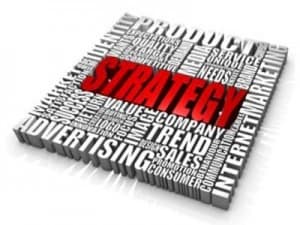What are the Apple Innovation Secrets of Steve Jobs?
Steve Jobs focused Apple innovation on competitive pressures and value propositions. He relentlessly focused organizational energy on customer-centered innovation and customer experience. In a nutshell, his innovation secret (if it can be called that) was the relentless pursuit of improving customer experience. As early as 2002, Steve Jobs told the world about his competitive strategy. During his statement, you can tell he was carefully evaluating competitive pressures and opportunities in the marketplace:
For those paying attention after Jobs’ return, the CEO was telegraphing Apple’s trajectory. “I would rather compete with Sony than compete in another product category with Microsoft… We’re the only company that owns the whole widget–, the hardware, the software, and the operating system. We can take full responsibility for the user experience. We can do things the other guys can’t do.” (comments to Time in early 2002).
Lashinsky, Adam, “The Decade of Steve – How Apple’s imperious, brilliant CEO transformed American Business,” Fortune Magazine, pg. 96. November 23, 2009.
Apple’s CEO owned the Apple corporate strategy, where he chose to do one simple thing that many companies talk about but few execute very well. Steve Jobs’ Business and IT strategy was completely focused on customer-centered innovation. He knew that you find business benefit looking outward, looking at market and business drivers rather than at products or services that exist in a silo.
I recently read a Fortune Magazine article extolling the virtues, or more the impact, of Steve Jobs on business. Certainly under Steve Jobs’ guidance, Apple has come to represent the best of business innovation for several reasons:
- Apple was built as an innovative company;
- After Jobs left Apple, the company nearly collapsed;
- He returned and turned the company around from the brink of collapse;
- Jobs at Apple, through his innovative guidance, transformed three primary industries: personal computers (laptops and desktops), personal music, and personal cell phones.
For this and other reasons, Steve Jobs’ time at Apple helped him become the king of American business transformation, at least according to Fortune Magazine.
The Direction of Apple’s Innovative Recovery and Company Turnaround
Just after the Y2K scare, the world was buzzing about the tech bubble burst. Many were also speculating about whether Steve Jobs’ return would revive Apple and watching the AMD and Intel Chip wars heat up. During this time, Apple strategically avoided a battle with its “logical” arch-rival Microsoft. To do so, Steve Jobs made a conscious decision to “take his marbles” and play a completely different game.
Rather than using a weak company that was struggling to stay afloat to challenge the dominant market maker, Steve Jobs refocused Apple’s innovation strategy on integrating technology and entertainment. Apple’s core competence at the time was in PCs and Laptops, but as Jobs said, they were the only vendor that did it all: hardware, software, and operating system. He took that same approach to music, helping develop the ecosystem to support the iPod and transform digital music distribution through iTunes.
The PC wasn’t new, but Jobs’ approach to customer-centered innovation was. The music player wasn’t new, but the iPod certainly was. Selling music “singles” wasn’t new, but the innovation on the iTunes store and the widespread use of the iPod, was. He created the device to play the music, and he created the channel to distribute the music. The cell phone wasn’t new, and while Blackberry and Nokia owned the market, the iPhone focused on innovative customer experience.
Start with a gut sense of an opportunity, and the conversations start rolling. As Jobs noted:
What do we hate?
A: Our cell phones.
What do we have the technology to make?
A: A cell phone with a Mac inside.
What would we like to own?
A: An iPhone, what else?
But Jobs also explained that in this specific conversation, there were big debates across the organization about whether or not they could and should do it. Ultimately, he looked around and said, “Let’s do it.”
I think it’s clear they also benefit from the inauspicious “leak” to the market. By that I mean this overly tight-lipped organization occasionally leaks early ideas to the market to see what kind of response they might generate. Again, what other company benefits from having thousands of adoring designers come up with beautifully rendered concepts of what they think the next great product should look like?
This PragMatic Marketing Post is about the idea that “you can’t innovate like Apple.” However, I disagree.
Steve Jobs isn’t dumb– quite the contrary. He’s smart enough to know that many businesses can innovate like Apple, and that’s why Apple’s internal innovation methods are kept so secret! Not only that, because the actual workings of Apple’s innovation are kept secret, the PragMatic article, like so many others, merely speculates about the details of the inner workings. In this article, we evaluated the actual company history and Jobs’ statements to have a clearer image of the company’s strategy.
From the very beginning of any market action by Apple, the corporate strategy is focused on being a market disrupter, and in turn a market maker, by improving the customer experience. And not just a focus with existing products or services– Apple relentlessly designed and developed new products and services to please the end customer.
The Apple innovation difference is less about an inward focus on how to squeeze every last penny out of some process or on reducing costs, such as what “Lean” and “Six Sigma” advocates. Instead, the Apple corporate focus as driven by the CEO was outwardly focused on the marketplace, on the customer, and how to direct that energy into improving revenue and profitability by addressing the frustrations (or needs/wants) of customers. The Apple innovation difference is where the role of CEO is fixated on customer-centered innovation.
Steve Jobs Innate Understanding of Marketing and Economics
One thing Apple did well at was listen to the market, and then shrewdly move marketing programs to create “pent-up demand” for a product that had not yet been released. These new products were designed to elegantly, and as intuitively as possible, address marketplace frustration.
Many commentators have interpreted this as Jobs having a “knack” for making market moves at the right time. In reality, Steve Jobs understood the fundamental core concepts of sales, marketing, and economics that few teach today.
Apple’s core of innovation was centered on one thing: market demand. Rather than following the “law of supply and demand,” they solely focused on the law of demand. Where there is marketplace frustration, there is internal “pent-up demand” for that frustration to be addressed.
You can see this thinking in Apple’s moves as of 2009. With the deep pockets of several successful product strategies, and on the heels of Microsoft’s dismal Vista operating system launch, Apple aggressively attacked their old arch rival. The market complained about Vista, about Microsoft security problems, about the forced upgrade march, about a whole host of problems Microsoft experienced. Apple seized on the market frustration with Microsoft products and the inherent, pent-up demand for an alternative. Apple’s timing simply capitalized on the Microsoft promotion of Windows 7. As a result, Apple’s marketing message resonated with the general populace and the pent-up demand from marketplace frustration. That message is that the Windows 7 operating system was simply another “fix” to a long line of broken operating systems.
At the time Microsoft brought out Windows 7 to address criticism of the Vista product, Apple offered an alternative. A very successful and financially healthy Apple started targeting Microsoft directly.
Steve Jobs as the Apple CEO became quite skilled at setting strategic direction along a future timeline. As the calculus of the recent attack on Microsoft’s new Windows 7 operating system shows, Steve Jobs was also very adept and skilled at holding back to determine the right timing to attack a market. Think about it: everyone in the IT world knew about the Windows Vista complaints for years. Over those years, that frustration in the marketplace mounted. Right on the heels of Microsoft’s boatloads of marketing spend to address negative market perceptions with a “new” Windows 7 flagship product, Apple pounced.
None of this is magic; none of it is mysterious. Steve Jobs as Apple’s CEO understood competitive pressures and value propositions. Steve Jobs also understood that the primary role of the CEO is to set strategic direction and long-term goals. Finally, he understood the real reason executive participation creates project success.
Does anyone really believe that the launch of iTunes, and the iPod, and the iPhone, or the attack ads on Microsoft were some seat-of-the-pants reaction? The quality and polish of Apple products, even when there are glitches, indicated that planning and strategy for all of these ventures took place quite some time in advance. Even rapid development cycles for hardware, software, and operating systems takes quite some time. Just to get the integration as seamless as Apple products often are is no small task. Many of Apple’s plans were probably several years in the making before being released to the public.
What Does All of This Have to Do with ERP and SAP?
A properly implemented ERP system such as SAP requires a solid corporate strategy that addresses competitive pressures. To achieve that elusive business benefit from the technology spend, you need to have business drivers, business strategy, and the future state direction built into the application.
The underlying ERP and SAP business case for ROI, business benefit, and success must be focused on the intersection IT and business strategy. The most successful business strategy is always looking carefully for upcoming market opportunities, and for enhancing the value proposition. In that business strategy, you have the opportunity for revenue, profitability, customer retention, and customer acquisition while focusing on the competitive drivers in the marketplace. At the intersection of that business strategy are IT, ERP, and SAP strategy. Like any capital investment, the way an asset is used, or not used, determines payback and success with its deployment.
=========================
More Posts on How to Successfully Carry out Innovation Initiatives in the Enterprise
=========================
From Collaboration to Innovation to Market – Toward a Working Model
A process-oriented approach to the first steps of a process model for moving from innovation to market. A first pass at integrating collaboration with a structured creative process.
=========================
Striving for a Customer Focused Approach to Innovation 1 of 3
Categorizing and defining the three primary types of corporate innovation. I have dubbed them “Stoic” (minimalist or continuous improvement), the “Stretch” (striving for a known future state), and the “Maelstrom” (directionless chaotic storm of ideas). The names you use really don’t matter, but these are the three types of what companies call “innovation” that I have seen.
=========================
Striving for a Customer Focused Approach to Innovation 2 of 3
Explaining the use of an “innovation narrative” in the “Stretch” type of innovation. This method produces a future state narrative that provides a customer- and market-focused direction for new products or services.
=========================
Striving for a Customer Focused Approach to Innovation 3 of 3
Practical ideas and practical application of some methods of moving toward an innovation culture. Some specific examples around how SAP (the big ERP vendor) has successfully integrated their customers, vendors, and their internal organization into an extended development dialog. Includes an overview of how this all ties into the collaboration model I started in a post entitled “From Collaboration to Innovation to Market toward a Working Model”.







Stealing “ideas” is far different than stealing someone’s developed & Patented technology. The UI of the Mac was an “idea” of HP PARC that was SOLD to Jobs in a primitive form just like Gates bought the system that became MS-DOS from Intergalactic Trading (no fooling look it up). Both were purchased in their raw state for $50,000 each. Gates built the Evil Empire on his purchase & Jobs built the Mac on his. Both had to do lots of their own engineering, time & capital into the finished product & deservedly had/have Patents on that TECHNOLOGY. Contrast this with Windoze, Andriod,etc which are COPIES of Apple Technology.